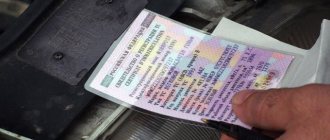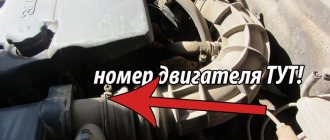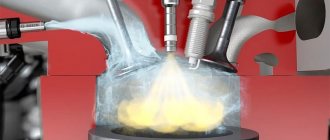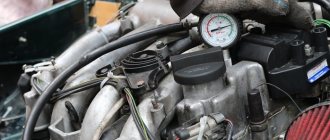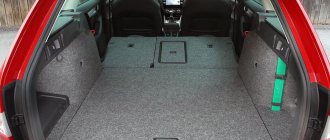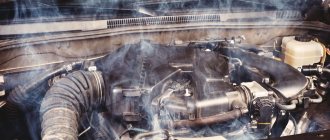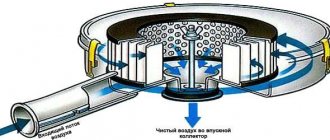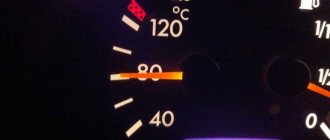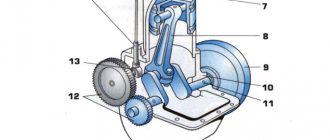The displacement of a car's engine is the sum of the working volumes of its cylinders. The units of measurement are both cubic centimeters (cm3) and liters (l.) (1 liter is equal to 1000 cubic centimeters):
1l=1000cm³
When the value must be indicated in liters, when converting units of measurement, rounding is done to a whole number after the decimal point, for example, if the value is 1598 cubic centimeters, the liters will be 1.6 liters, and, for example, the volume of 2429 cubic centimeters will be 2. 4 liters.
The vehicle's power, fuel consumption and other operating parameters directly depend on the engine displacement.
There are several ways to find out engine size:
- This characteristic is indicated in technical passport vehicle. There are “craftsmen” who like to advise unscrewing all the spark plugs and pouring water into the cylinders “to capacity”. The volume of water placed in them, according to them, should be the same as that of the engine. This method should not be used, as it is just an old joke.
Click on photo to enlarge - If you buy a used car, the numbers indicated in its registration certificate may not be entirely correct. It is possible that the car was involved in an accident or perhaps some work was carried out on it that affected the engine's performance. What if it was actually assembled from several cars? The actual volume, in these cases, can be found out by looking at the numbers on the cylinder block. This is the value of the working volume. They are indicated at the back with large symbols (you can see them from the pit).
- And of course, according to the VIN code.
Engine displacement characteristics
- minicars (no more than 1.1 liters);
- small cars (from 1.2 to 1.7 liters);
- medium volume (from 1.8 to 3.5 liters);
- large-capacity (from 3.6 or more liters).
This division is quite arbitrary and concerns mainly engines running on gasoline. With diesel engines the situation is slightly different. The displacement indicator of power plants is one of the most important parts of a car. The more fuel mixture is placed in the combustion chamber, the more gasoline the car consumes. But along with fuel consumption, the power of the car also increases, because more fuel will produce a greater amount of released energy.
The disadvantages of large-capacity cars, in addition to fuel consumption, include their higher cost. So, it is logical to assume that much more materials will be required for its manufacture, and the requirements for the quality of manufactured parts will, accordingly, be much higher.
This is interesting: Where is the VIN number of Lada Granta
How to find out the engine size of a car
In the era of development of the automotive industry, a huge number of new automobile products appear that have advanced technologies in the field of design of motor units. New types of engines are being developed, such as hybrids, and new classes of cars are emerging, for example, electric cars. Due to the great variety of engines available on the market, it is difficult for the buyer to decide on the choice of a future car that will serve as a means of transportation at a certain stage of his life. Today we’ll talk about how to find out the engine size.
Types of engines
How to decide on a motor unit? Let's first understand its classification. So, the heart of a car is divided into several types: internal combustion engines and electric motors. However, due to the problem of charging electric cars, the most popular are cars with internal combustion engines. They are divided into gasoline and diesel. Their difference is that engines running on gasoline require an electric spark, which is important for igniting the fuel. The fuel mixture in diesel units can ignite on its own. Each type of engine has its own advantages and disadvantages. Cars with a diesel engine have more torque, they are more economical, by about 20 percent, and accordingly, such cars have a longer range.
Diesels are more reliable due to the fact that they operate without electronic devices, and even in the event of a breakdown, repairing such engines will cost much less than gasoline ones.
As for the disadvantages of engines running on diesel fuel, first of all, this is their weight, which negatively affects the maneuverability of the car; in winter the car will have to warm up for a long time. In vehicles with a gasoline engine, which is jokingly called a “lighter,” the maximum power is slightly higher than diesel engines and, accordingly, the maximum speed is also higher.
But they have a smaller appetite and are less reliable. There are cars with an electric unit.
However, they are much more expensive than usual and the problem of charging the engine is still relevant, not to mention the maintenance of such vehicles. Discounts on new cars! Advantageous loan from 9.9% Installment plan 0%
Powertrain differences
So, you have decided on the type of engine, now you need to select its size. Now there are a lot of units on the market: from the weakest and most economical to the most powerful and gluttonous. Let's talk about their advantages and disadvantages. For engines with large displacement, the tax has been increased, the cost of maintenance and, accordingly, fuel consumption are significantly higher.
A powerful car will serve you for a long time, and if used correctly, it will also be a reliable assistant, because the engine does not suffer from overload and can be fully operated with the air conditioning and other electronic systems turned on.
For low mileage, it makes sense to buy a car with a small engine to avoid high power taxes. It is very important to choose the right parameters and decide on the intended type of operation of the car. Let's compare different volumes of units:
Determining engine size
Now let’s talk about how to find out the displacement of a car unit. There are several ways. You can look at the volume in the car’s technical passport, but this method is not entirely suitable when buying a used car. Perhaps the engine configuration was changed or modernized. The actual value can only be found on the cylinder block.
You can also determine the engine displacement by the VIN code. You should look for it under the rear seat, under the windshield, or at the bottom of the driver's door arch. This code consists of seventeen characters.
What is engine displacement
The main characteristic of a power unit (diesel, gasoline) installed on a car or truck is its displacement. The parameter must be indicated when selling a car; important characteristics of the vehicle depend on its value:
- power;
- acceleration speed;
- volume and weight of transported cargo.
Reference!
In documentation, descriptions, and instructions, the engine displacement value is indicated in cubic centimeters or liters.
A mixture of gasoline and air enters the cylinder cavity, during combustion it moves the piston, it moves up and down from the bottom to the top point. The extreme positions are designated by the abbreviations BDC, TDC - top and bottom, respectively.
Parameters that determine the working volume:
- Piston stroke (H) is the distance between the extreme upper and lower positions.
- Combustion chamber volume (Vks). This is the space above the piston when it is at its extreme TDC position.
- The total volume of the cylinder (Vpol) is the space under the piston when it is in the extreme BDC position.
Working volume of one cylinder (Vlab) = Vpol – Vks. To determine the total displacement of the power unit, you need to multiply Vwork of one cylinder by the number of cylinders.
Classification of cars by engine size:
| Displacement (l) | Passenger car classes |
| ≤ 1,1 | Minicar |
| 1,2-1,7 | Subcompact |
| 1,8-3,5 | Mid-sized |
| > 3,5 | Large |
How to increase horsepower in a car
You can increase the power of your car in several ways. Machine modernization options can further ensure fuel economy, increase the service life and performance of the fuel system.
More volume
One of the simplest and most effective methods to increase the number of horsepower. In this case, the edges of the cylinder block liners are bored, increasing their internal diameter, and pistons of larger diameter are installed. Thus, the engine displacement is increased, horsepower increases, and torque also increases.
Thanks to this improvement, fuel consumption is reduced. For further operation, it is necessary to use only gasoline with a high octane number (95-98).
Modernization of the intake system
Such changes are used as an addition to the global modernization of the car. Improving the intake system, as an independent method, gives too little increase in horsepower.
To refine the intake system, replace the installed air filter with a zero filter, and install a larger throttle valve. They also replace the receiver with a larger one and remove the intake manifold.
Chip tuning
The principle of improvement in setting up the calibration of the electronic control unit firmware. This is the most effective method to increase vehicle power and significantly reduce fuel consumption. Such work is carried out only by specialists at the service station.
Cylinder volume: what formula to use
To solve this problem, a convenient tool can be useful - an online calculator. If you are interested in the question of how to find out the working volume of a cylinder in your own passenger car , you will need some of its characteristics, namely height and radius divided by diameter.
You can independently calculate the volume of a cylinder using the formula:
V=πr2h
- The symbol V denotes volume,
- R - radius,
- h - height,
- π is the number Pi.
If the diameter is known, then the formula will help calculate the volume of the cylinder:
V=(πD2/4)h
Instead of the radius, the diameter value is indicated. Having the necessary characteristics, computing operations will not seem like a complicated process.
Car engine power calculator
Pit calculation calculator, cost of excavation work, calculation of pit volume of different shapes
Tire load index calculator
Injector performance calculator
Calculator for empirical calculation of oil change intervals based on actual fuel consumption
How to calculate power through torque
The simplest calculation of car engine power can be determined by the relationship between torque and revolutions .
Torque
The force multiplied by the leverage of its application, which the engine can produce to overcome certain resistance to movement. Determines how quickly the motor reaches maximum power. Calculation formula for torque based on engine volume:
Micro = VHxPE/0.12566
, Where
Engine speed
Crankshaft rotation speed.
The formula for calculating the power of an internal combustion engine of a car is as follows:
P = Mkr * n/9549 [kW]
, Where:
Since according to the formula, we get the result in kW, then, if necessary, you can also convert to horsepower or simply multiply by a factor of 1.36.
Using these formulas is the easiest way to convert torque to power.
And in order not to go into all these details, a quick calculation of the power of an internal combustion engine online can be done using our calculator.
But, unfortunately, this formula reflects only the effective power of the motor, which does not all reach the wheels of the car. After all, there are losses in the transmission, transfer case, parasitic consumers (air conditioning, generator, power steering, etc.) and this does not take into account such forces as rolling resistance, lifting resistance, aerodynamic resistance.
Calculation methods and formulas
The volume is easy to calculate if the values of the piston radius (R) and piston stroke (H) are known. The values must be substituted into the formula (3.14 × R² × H). The result obtained is equal to the working volume of one cylinder; to find out the displacement of the engine, you need to multiply it by the number of cylinders.
Formula for calculation: Veng = ((3.14 × R² × H) × number of cylinders)/1000. Divide by 1000 to convert mm³ to cm³.
On a note!
There are calculators on the Internet for calculating engine volume: just fill out the fields and click the “Calculate” button. You can measure the diameters of the cylinders with a micrometer and a bore gauge.
This is interesting: How to check ball joints on a Lada
What does displacement affect?
Engine size determines the characteristics of the model (maximum speed, torque, acceleration dynamics) and affects the cost of the car. The more powerful the engine, the more complex the other mechanisms (brake system, cooling system, transmission), the more expensive the scheduled maintenance, the higher the fuel and engine oil consumption.
On a note!
Budget small cars consume little fuel: an internal combustion engine with a volume of 1.2-1.7 liters provides sufficient dynamics for the city.
The larger the displacement, the higher the maintenance costs:
- technical inspection;
- insurance;
- registration, deregistration;
- tax;
- customs clearance.
The high price of a car with a large engine is compensated by the comfort of operation, especially in the cold season. The engine warms up faster, is less demanding on the quality of gasoline, and requires major overhauls with higher mileage.
When choosing a new or used car, you always evaluate the engine size. Small cars are not suitable for lovers of long trips: a 1.2-1.7 liter engine does not have enough power at a speed of 100 km/h. For long trips and moving within the city, cars with a displacement of 1.8-3 liters are suitable: they can transport cargo, the engine has enough power when accelerating and driving at high speed. You can find out the working volume from the PTS or using a formula through accurate measurements.
Classification of cars based on engine size
Since there is no vehicle that would meet the needs of all motorists, manufacturers create engines with different characteristics. Everyone, based on their preferences, selects a certain modification.
Based on engine displacement, all cars are divided into four classes:
- Minicars are cars with an engine whose volume does not exceed 1.1 liters. For example, such vehicles include CITROEN C1 and FIAT 500C.
- Subcompact cars are cars whose internal combustion engine capacity varies from 1.2 to 1.7 liters. Such machines are popular among those who value minimal consumption with average performance. Representatives of this class are DAIHATSU COPEN 2002-2012 and CITROEN BERLINGO VAN.
- Medium displacement - the power unit in such cars has a volume of 1.8 to 3.5 liters. This class includes models such as the BUICK REGAL TOURX and LAND ROVER RANGE ROVER EVOQUE.
- Large cars - in such cars the internal combustion engine volume will be more than 3.5 liters. Representatives of this class include: ASTON MARTIN VANQUISH VOLANTE 2013, CHEVROLET CAMARO 2021 and BENTLEY CONTINENTAL GT CONVERTABLE.
This classification applies to gasoline units. Often in the description of characteristics you can find slightly different markings:
- B - compact cars with a displacement of 1.0 - 1.6. Most often these are budget options, such as SKODA FABIA.
- C – this category includes models that combine an average price, good performance, practicality and a presentable appearance. The engines in them will be from 1.4 to 2.0 liters. A representative of this class is the SKODA OCTAVIA 4.
- D – most often these cars are used by business people and families. In cars, the engine will be 1.6-2.5 liters. The list of models in this class is no shorter than in the previous segment. One such car is the VOLKSWAGEN PASSAT.
- E – business class vehicles. The internal combustion engine in such models is most often 2.0 liters. and more. An example of such cars is the AUDI A6 2021.
In addition to displacement, this classification takes into account such parameters as the target segment (budget model, mid-price or premium), body dimensions, and comfort system equipment. Sometimes manufacturers equip middle and upper class cars with small engines, so it cannot be said that the presented markings have strict boundaries.
When a car model is between segments (for example, according to technical characteristics it is class C, and comfort systems allow the car to be classified as class E), “+” is added to the letter.
In addition to the mentioned classification, there are other markings:
- J – SUVs and crossovers;
- M – minivans and minibuses;
- S – sports car models.
The engines of such cars can have different volumes.
How to Determine Vehicle Engine Size
by Contributing Writer Updated June 12, 2021
The size of the engine running on the vehicles may also be specified. Decrypting your vehicle is a simple process that usually requires a phone call to your local dealership. There are also several vehicle decoder sites on the Internet. However, the most reliable way to determine engine size is a quick call to a professional vehicle dealership.
How to determine engine size by VIN
Locate the 17-digit VIN on your vehicle. The most common areas for the VIN are on the dashboard near the base of the windshield, inside the glove compartment, or on the inside door frame.
Write down the 17-digit code.
Call your local dealership for your vehicle's make and ask to speak with a representative who can help you decipher the VIN.
Read your VIN to the dealer and ask him to decipher the engine size for your vehicle.
How to Determine Engine Size for a 1977 Ford F-150
engine size Locate the "Vehicle Certification Plate" on the driver's door pillar. Open the driver's door and look where the door latch, it is directly above the latch where the door closes. On the cabin, not on the door.
Write the number in the upper right corner of the label. It is 11 characters long and will look something like this: "F25HLDC0000".
Notice the fourth character, which will be a letter. It stands for as follows: “B” -300 cubic inches inline-six; "G" -302 cubic inch V-8; "H" -351 cc. Inch V-8; "M" - 390 cubic inch V-8; "S" -400 cubic inch V-8; "J" is a 460 cubic inch V-8. In the example above "F25HLDC0000" the "H" is the engine code indicating a 351 cubic inch V-8.
How to Determine Ford Ranger Engine Size
Open the hood and locate the emissions sticker on the top radiator support. The engine family is indicated in small print in a box in the lower right corner of the sticker. It is not labeled as such, but can be identified by the use of a standard engine format - "2.3L", "4.0L", etc.
Locate the 17-digit VIN under the windshield on the driver's side of the dash. Write down the VIN and use a VIN decoder website, such as the one in the Resources section of this article, to determine your specific engine size. Alternatively, you can write down the 8th digit of the VIN, which is the engine code, and decode that digit based on your year and model.
Look in your owner's manual or refer to the online manual for your year and model and look in the "Engine Compartment Component Identification" section. By comparing the pictures in the manual to the location of the components in the engine bay, you can identify the engine in your Ranger.
What characteristics are affected by displacement?
The main parameter on which the power of the car will depend is the engine size. For example, if a modification of 1.5 liters and 120 hp is installed under the hood, then an analogue with an increased volume of up to two liters will naturally be more powerful.
However, displacement should not be considered the only factor affecting power. The characteristics of the engine can change significantly if there is a turbine, changed dimensions of the crank mechanism and a variable valve timing system.
What else does engine size affect?
- Dynamics. The combination of modern gas distribution technologies and a large volume of cylinders allows you to increase the peak speed of the car and reduce acceleration time. These parameters can also change significantly if the manufacturer installs special connecting rods and crankshaft into the engine.
- Cost of the car. Models with a powerful engine will require a more reliable gearbox, improved braking system, suspension, and tires. This is necessary because the driver will try to use the full potential of the vehicle, which means the car will drive fast. The production and maintenance of such vehicles will be more expensive.
- Fuel consumption. Cars with 1.5-liter power units in city mode consume an average of 6-7 liters per 100 km, and medium-displacement cars consume about 9-14 liters per 100 km. The “gluttony” of large-capacity models starts at 15 liters. However, these parameters are relative. So, for dynamic driving in a small car, the driver will often have to “turn” the engine at high speeds, which will certainly lead to excessive fuel consumption. And if the car is equipped with air conditioning, then the small car will be no less voracious than an analogue in a higher class.
The relationship between consumption and volume of an internal combustion engine is described in more detail in the video:
How are fuel consumption and engine size related?
An easy way to determine engine type
What is the engine size in the Lada Granta?
Is it possible to determine the car engine model without wasting time? The first way is to look under the hood of your iron horse. Some automakers mark their power units on the assembly line, indicating the engine brand and its series. For example, the designation “OM” means that your car’s engine is manufactured by Mercedes. By looking at the manufacturer and engine series number on the Internet, you can quickly find all the necessary information about the engine and its characteristics.
It is not always possible to recognize the type of engine by its markings. Most often you can find a special unit number on the engine. It can be found on the engine (location will vary for different models). You can decipher the meaning of the code using Internet sources or special reference books. This code on the power unit housing consists of the following elements:
- The first character is a letter indicating the year of manufacture.
- The next four digits indicate the modification of the motor.
- The last designation is the climate version.
Below, under the main code, there is an additional series designation. But it is not needed to define the model.
Determination by vehicle VIN code
How to find out the engine model using a special VIN code? Determining the engine brand by VIN is the third method.
The VIN code consists of three groups of characters:
- The first 3 characters indicate the country and the car manufacturer (WMI).
- 6 subsequent characters – car model, engine modification (VDS).
- The last 7 characters are the serial number with encryption of the year, place of manufacture of the car and other information about the manufacturer (VIS).
Determining the parameters of a car by VIN code is not difficult. There are special databases for deciphering codes. In addition, if you buy a car secondhand, the VIN number can be checked against the database of cars that are stolen or wanted. To obtain complete information about the car, for example, country and date of production, configuration, VIN can be decrypted through online services on the Internet.
How else can you find out engine parameters?
The methods described above will not in all cases help to accurately determine the parameters and capabilities of the car. The VIN number may contain errors or changes by third parties. One of the possibilities for conducting additional examinations to determine the type of motor is to contact the MREO. Upon your request, the car will be sent for diagnostics to the base of a technical institute. Of course, this method requires patience and waiting time, but the results will be 100% accurate. But there may be snags here too. MREO cannot always provide accurate information about the vehicle’s parameters, and technical bases may simply refuse to conduct an examination or delay the inspection period for a long time. What to do in this case?
In such situations, it is possible to accurately determine the type of power unit only through technical expertise. To do this, you should contact a service center. The price of such a service is relatively low (up to 3 thousand rubles). If it is impossible to check at a service center, then you can write to specialized automobile forums or contact the car manufacturer directly. To do this, indicate in the letter the following known characteristics of the car:
- The number of cylinders and their location, the type of intake and the number of cylinder heads.
- Location of spark plugs, valves, manifolds and injectors in the engine.
- The type of transmission, as well as the symbols or numbers that are on the car or engine, even if they are not completely preserved.
- The location of the electronics, the color of the wires and the presence of additional equipment, such as air conditioning.
By sending this information, detailed photographs of your car and engine to the automaker, you will receive accurate information about the type of engine in the car.
Which way is easier?
To accurately determine the type of motor and its modification, it is enough to use the first three methods. They give the answer with more than 90% accuracy. In cases where the power unit has undergone certain changes, it will be more difficult to determine the exact modification.
The most reliable way is to contact the MREO. But sometimes you can’t do without a service center. This is especially true for cars that were manufactured before 1991. At that time, some automakers did not label cars, so it would be difficult to determine whether an engine belonged to a specific modification.
Pros and cons of internal combustion engines with large and small volumes
Each type of engine has its own advantages and certain disadvantages, which can significantly affect the choice of a new car.
Advantages of small-displacement internal combustion engines:
- cheaper cost and maintenance of other parts, for example, gearboxes and chassis;
- economical fuel consumption;
- The turbocharged version combines high performance with minimal loads and a small displacement.
Disadvantages of small displacement engines:
- weak power, which is why the car has a small carrying capacity;
- insufficient dynamics;
- low engine life due to frequent driving at high speeds;
- The turbocharged version is very expensive to maintain.
Advantages of displacement engines:
- power is higher than that of economical analogues;
- increased service life (the engine operates at maximum speed less often, so it will last longer);
- excellent dynamics (to overtake less often you need to switch to a lower speed);
- warm up faster in winter;
- atmospheric modifications are not picky about fuel quality.
Disadvantages of volumetric power units:
- maintenance is more expensive than in the case of an economical analogue (you need to fill in more oil and coolant, install a better gearbox, suspension and brakes);
- high taxes upon re-registration (purchase on the secondary market) and customs clearance;
- increased fuel consumption.
As you can see, engine size is closely related to additional waste, both in the case of small cars and more “gluttonous” analogues. In view of this, when selecting a car modification based on displacement, every motorist must proceed from the conditions in which the car will be operated.
For what parameters to select a car - see this video:
How to choose a car, which engine is better?
Home » Articles » What does engine volume mean?
The principle of operation of the internal combustion engine
Operating principle of an internal combustion engine:
- The combustion chamber of the power unit is filled with a fuel mixture (gasoline with air). The chamber is designed so that it has a movable element (piston).
- Then, using a special device called a “spark plug,” the fuel mixture ignites.
- The energy released as a result of the “explosion” pushes the piston down, which in turn transmits the movement to the crankshaft, which, through various gearboxes, begins to spin the wheels.
This is the simplest description of the operation of the engine; in fact, there are a huge number of nuances, but it also allows us to answer the question of how to find out the volume of a gasoline engine.
Now it is clear that the volume of any engine is the total value of all combustion chambers of the engine. What does this indicator affect? First of all, on the power of the car. Although modern cars are increasingly using turbocharging, which allows inventors to increase power while leaving the volume of the combustion chamber unchanged.
Calculation of internal combustion engine volume with a calculator
To calculate the volume of the engine you are interested in, you need to enter 3 numbers in the appropriate fields - the result will appear automatically. All three values can be found in the car’s passport data or technical data. characteristics of a particular part, or a caliper will help determine what piston volume.
Thus, if, for example, you find that the volume is 1598 cm³, then in liters it will be designated as 1.6 liters, and if the number is 2429 cm³, then 2.4 liters.
Long-stroke and short-stroke piston
Also note that with the same number of cylinders and engine displacement, the cylinder diameters, piston strokes and power of such engines may also be different. An engine with short-stroke pistons is very power hungry and has low efficiency, but achieves great power at high speeds. And long-stroke ones are located where traction and efficiency are needed.
Therefore, the question “how to find out engine size by horsepower” can be given a firm answer - no way. After all, although horsepower has a connection with engine volume, it will not be possible to calculate it from them, since the formula for their relationship also includes many different indicators. So the cubic centimeters of an engine can be determined solely by the piston parameters.
Calculating engine cylinder volume: tips, explanations, formulas
As you know, the volume of a car engine is the sum of the volumes of all its cylinders. However, the formula for calculating the volume of a cylinder is published in various versions, which is sometimes confusing, especially for inexperienced drivers. And yet, regardless of the option used, the calculation principle in all cases remains the same. How much hot air mixture can an engine cylinder pass at one time? It’s immediately worth noting that the more, the higher the torque will be, as well as the engine power. What does “at one time” mean? A four-stroke engine completes a full cycle in 2 revolutions of the crankshaft, that is, intake, compression, power stroke and exhaust occur. So 2 revolutions or 4 measures are counted at one time.
Calculation of cylinder volume
This value is measured in cubic meters or centimeters or in liters. 1000 cm3 equals 1 liter. When specifying engine volume in liters, you must round to one decimal place. For example, if the engine capacity is 1486 cm3, then when converted to liters it should be designated as 1.5 liters; if the volume is 2526 cm3, then it should be written as 2.5 liters. The cylinder displacement of car power units is different.
The concept of cylinder displacement
The cylinder displacement is the volume between the extreme positions of the piston movement. It is filled with a combustible warm-air mixture during its intake when the piston moves from the upper extreme position to the lower one. Approaching the top dead position, the piston leaves a free volume - the combustion chamber, or compression. To calculate the full volume of the cylinder, you need to sum up the volume of the chambers and the working volume. The compression level is a value that is defined as the quotient of the total division in one cylinder and the volume of the combustion chamber. This parameter determines the degree of compression of the combustible mixture in the cylinder. The engine power depends on it, because the higher the compression level, the stronger the burning mixture presses on the piston. Increasing the compression level is beneficial, since in this case the portion of fuel can do more useful work. However, if the compression level is increased excessively, the mixture may spontaneously ignite or burn too quickly and the fuel may detonate. As a result of rapid combustion of the working mixture, the power unit operates unstably.
Detonation can be identified by a sharp knocking sound, a decrease in engine power and thick black smoke from the exhaust pipe. Automotive designers are constantly looking for ways to eliminate fuel detonation when increasing the compression ratio. The compression level determines the need to use a specific type of fuel.
An increase in engine power is affected by an increase in the number of crankshaft revolutions per minute. But even here there are obstacles. This is a lack of time for the combustible mixture to enter the cylinder, the difficulty of removing exhaust gases, as well as excessive acceleration of the operation of parts and mechanisms, leading to their rapid wear. To overcome these obstacles, designers increase the number of crankshaft revolutions. For multi-cylinder power units, the cylinder volume is calculated, after which these volumes are summed up to obtain the engine displacement. An increase in engine power is a consequence of an increase in its displacement. And this parameter is determined by the class of the vehicle.
Variable displacement
Providing variable cylinder displacement is an urgent task. To achieve this effect, technology is used to automatically stop some of the cylinders when the engine is not fully loaded. This system is already used in some models of pickup trucks and SUVs, with fuel savings averaging about 20%. There are also special engines that use mechanical transformation of the piston stroke. However, they are still at the development stage. It is worth noting that internal combustion engines with variable cylinder displacement are used as laboratory equipment, allowing the octane number of gasoline to be determined “by motor method.”
Online calculator
The volume of a cylinder can be calculated using:
- base radius and height, with the height equal to the piston stroke;
- base area and height.
But there are also more complex calculators with an expanded range of functions. They allow you to calculate not only engine volume, but also the compression ratio. For calculations, the values of the following parameters are required:
- connecting rod length;
- piston stroke;
- piston under-return;
- cylinder diameter;
- piston chamber volume;
- thickness and diameter of the gasket;
- chamber volume in the cylinder head;
- number of cylinders.
Before calculating the volume of a cylinder or the entire engine, or calculating the compression level, you should clarify and record all of the above parameters. Beginners may have difficulty with this, so they will have to be persistent.
FAQ
How is engine displacement measured?
Engine displacement is measured in cubic centimeters
(cm3), but in documentation it is often written in liters (l.). 1000 cubic centimeters equals 1 liter. The most accurate unit for measuring volume is cubic centimeters, since when the volume of a car engine is indicated in liters, it is rounded to a whole number after the decimal point. For example, the volume is 2.4 liters. equal to 2429 cm3.
What is the formula for engine cylinder displacement?
The working volume of the engine cylinder is equal to the product of Pi (3.1415) by the square of the radius of the base and the height of the piston stroke in it. The formula itself for the volume of an internal combustion engine cylinder in cubic meters. centimeters looks like this: Vwork = π⋅r²⋅h/1000
How to measure car engine displacement?
Engine volume is the sum of the working volumes of all its cylinders; accordingly, you must first find out what the volume of one cylinder is, and then multiply by their number. The volume of a cylinder is calculated by multiplying the height by the square of the radius and the number “Pi”. But in order to measure exactly the working volume of a cylinder in an engine, you need to take the length of the piston stroke from BDC to TDC as the height, and the radius can also be measured with a ruler, having first found out the diameter of the cylinder. This measurement method is only possible when the head is removed or the parameters are known.
Determining engine size
Now let’s talk about how to find out the displacement of a car unit. There are several ways. You can look at the volume in the car’s technical passport, but this method is not entirely suitable when buying a used car. Perhaps the engine configuration was changed or modernized. The actual value can only be found on the cylinder block. You can also determine the engine displacement by the VIN code. You should look for it under the rear seat, under the windshield, or at the bottom of the driver's door arch. This code consists of seventeen characters.
The first three characters are responsible for the country and manufacturer of the car, characters from the fourth to the eighth explain basic information about the technical equipment of the car (engine size, body, and much more). Using the tenth digit you can find out whether the car was stolen. Signs numbered 12 to 17 are the car body number. You can find out the meaning of the VIN code on the Internet. On many sites this service is absolutely free.
You can choose the type and volume of the unit according to your taste and color
However, for long-term operation of a car, proper care is required for its most important part, its heart - the engine. In case of any malfunction, you should contact only qualified employees of the manufacturer’s official service center.
If you love to ride, you also love to carry a sled. Good luck with your automotive use. Love your car and get only positive emotions from it.
Let us know if you found this article helpful.
The displacement of a car's engine is the sum of the working volumes of its cylinders. Units of measurement are both cubic centimeters (cm3) and liters (l.) (1 liter equals 1000 cubic centimeters)
When the engine volume must be indicated in liters, when converting units of measurement, rounding is done to a whole number after the decimal point, for example, an engine volume of 1598 cubic centimeters in liters will be equal to 1.6 liters, and, for example, a volume of 2429 cubic centimeters — 2.4 liters. The size of the engine displacement directly affects the car’s power, fuel consumption and other operating parameters. When buying a car, you must definitely pay attention to the engine displacement, as this is a very important point. By the way, many car owners, after purchasing a car, often wonder how to find out the engine size on their own, what it really is. This characteristic is indicated in the technical passport of the vehicle
There are “craftsmen” who like to advise unscrewing all the spark plugs and pouring water into the cylinders “to capacity”. According to them, the volume of water placed in them should be the same as the volume of the engine. This method should not be used, as it is just an old joke. If you buy a used car, the numbers indicated in its registration certificate may not be entirely correct. It is possible that the car was involved in an accident or perhaps some work was carried out on it that affected the engine's performance. What if it was actually assembled from several cars? The actual engine volume, in these cases, can be found out by looking at the numbers on the cylinder block. This is the value of the working volume. They are indicated at the back with large symbols (you can see them from the pit). You can also find out what size the car’s engine is by looking at the VIN code. You can see it at the bottom of the driver's door arch, naturally, after opening it first. It is also indicated under the rear seat, under the windshield and in the upper left part of the instrument panel (in this case, the code must be looked at from outside the car).
The last method listed is the most reliable. Since the VIN code is indicated on all cars that were produced starting from about 1980. It consists of seventeen characters, among which the Latin letters I, O and Q are not used due to their similarity with the numbers 1 and 0. The first three characters indicate the car manufacturer’s index. (The first is the country, the second characterizes the manufacturer, and the third indicates the type (car, truck, etc.). From the fourth to the eighth characters inform about the main technical parameters of the car: the model, engine type and size, body type, and so on. The ninth character is the check digit. It is needed so that the authenticity of the VIN code can be determined. With its help, you can find out whether the car is listed as stolen. The twelfth to seventeenth characters are the car body number. There are many sites on the Internet with which you can decipher the VIN code and find out not only the engine size of a particular car, but also all other technical characteristics. Moreover, it is absolutely free.
